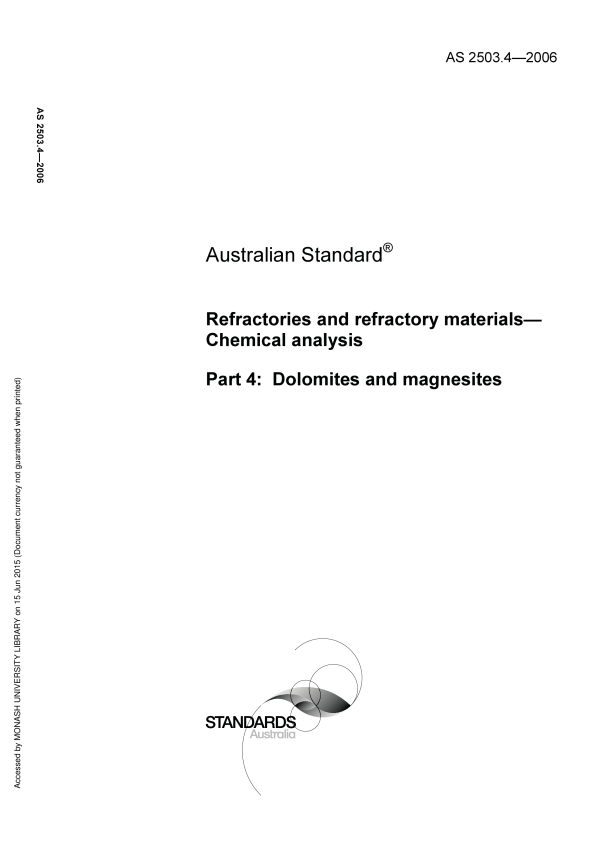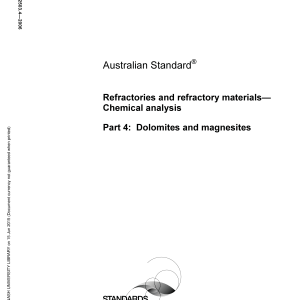🔍

Purchase the full subscription package now and enjoy a 40% discount, along with free updates for future editions.
AS 2503.4-2006
$149.01
Refractories and refractory materials — Chemical analysis, Part 4: Dolomites and magnesites
Sets out methods for the sampling, preparation of samples and analysis of dolomite and magnesite refractories and refractory materials.
Table of contents
Header
About this publication
Preface
1 Scope and general
1.1 Scope
1.2 Referenced documents
1.3 Definitions
1.4 Repeatability
1.5 Principle
1.5.1 Loss on ignition (see Section 3)
1.5.2 Determination of silicon, iron, titanium, manganese, chromium, aluminium, calcium and magnesium oxides (see Section 4)
1.5.3 Determination of sodium, potassium and lithium oxides (see Section 5)
1.5.4 Determination of boron in magnesite (see Section 6)
1.6 Safety
2 Sampling and sample preparation
2.1 Scope of section
2.2 Gross sampling
2.2.1 Shaped materials
2.2.2 Bulk or ground materials
2.3 Preparation of sample
2.3.1 Crushing
2.3.1.1 Shaped products
2.3.1.2 Bulk or ground materials
2.3.2 Samples for analysis
2.3.2.1 Preliminary treatment
2.3.2.2 Portion A—to be used for the main analysis (see Note to 2.3.2.1(c))
2.3.2.3 Portion B—to be used where iron determination is required
3 Determination of loss on ignition
3.1 Scope of section
3.2 Apparatus
3.2.1 Balance
3.2.2 Drying oven
3.2.3 Muffle furnace
3.2.4 Platinum crucible
3.3 Procedure
4 Determination of silicon, iron, titanium, manganese, chromium, aluminium, calcium and magnesium oxides
4.1 Scope of section
4.2 Reagents
4.2.1 General
4.2.2 Solid reagents
4.2.2.1 Ammonium chloride (NH4CL)
4.2.2.2 Boric acid (H3BO3)
4.2.2.3 Potassium periodate (KIO4)
4.2.2.4 Sodium carbonate, anhydrous (Na2CO3)
4.2.3 General solutions and solvents
4.2.3.1 Acetic acid (500 mL/L)
4.2.3.2 Ammonia solution (ς20 880 kg/m3)
4.2.3.3 Ammonia solution (500 mL/L)
4.2.3.4 Ammonium acetate buffer solution
4.2.3.5 Ammonium acetate buffer solution (pH 3.8)
4.2.3.6 Ammonium acetate buffer solution (pH 6.0 to 6.5)
4.2.3.7 Ammonium cerium(IV) nitrate solution (10 g/L)
4.2.3.8 Ammonium molybdate solution (100 g/L)
4.2.3.9 Ammonium nitrate solution (10 g/L)
4.2.3.10 Chloroform.
4.2.3.11 Cupferron solution (60 g/L)
4.2.3.12 Diphenylcarbazide solution (10 g/L)
4.2.3.13 Ethanol or industrial alcohol (950 mL/L)
4.2.3.14 EDTA solution (50 g/L)
4.2.3.15 Flocculating agent (1 g/L)
4.2.3.16 Hydrochloric acid (ς20 1180 kg/m3).
4.2.3.17 Hydrochloric acid (500 mL/L)
4.2.3.18 Hydrochloric acid (250 mL/L)
4.2.3.19 Hydrochloric acid (200 mL/L)
4.2.3.20 Hydrochloric acid (100 mL/L)
4.2.3.21 Hydrochloric acid (50 mL/L)
4.2.3.22 Hydrofluoric acid (ς20 1130 kg/m3).
4.2.3.23 Hydrogen peroxide solution (60 g/L)
4.2.3.24 Hydroxylammonium chloride solution (100 g/L)
4.2.3.25 Magnesium sulphate solution (0.2 g MgO/100 mL)
4.2.3.26 Nitric acid (ς20 1420 kg/m3)
4.2.3.27 1,10-Phenanthroline solution (10 g/L)
4.2.3.28 Phosphoric acid (400 mL/L)
4.2.3.29 Phosphoric acid (100 mL/L)
4.2.3.30 Polyethylene glycol solution (2.5 g/L)
4.2.3.31 Potassium hydroxide solution (250 g/L)
4.2.3.32 Sodium azide solution (20 g/L)
4.2.3.33 Sodium diethyldithiocarbonate solution (100 g/L)
4.2.3.34 Sodium sulphite solution (50 g/L)
4.2.3.35 Sulphuric acid (ς20 1840 kg/m3).
4.2.3.36 Sulphuric acid (500 mL/L)
4.2.3.37 Sulphuric acid (100 mL/L)
4.2.3.38 Sulphurous acid.
4.2.3.39 Tin(II) chloride solution (10 g/L)
4.2.3.40 Triethanolamine solution (500 mL/L)
4.2.4 Standard solutions.
4.2.4.1 Calcium solution (0.050 mol/L)
4.2.4.2 Chromium(III) solution (1 mL ≡ 0.50 mg Cr2O3)
4.2.4.3 Chromium(III) solution (1 mL ≡ 0.025 mg Cr2O3)
4.2.4.4 CDTA solution (approx. 0.05 mol/L)
4.2.4.5 EDTA solution (approx. 0.05 mol/L)
4.2.4.6 EGTA solution (approx. 0.05 mol/L)
4.2.4.7 Iron(III) solution (1 mL ≡ 1.00 mg Fe2O3)
4.2.4.8 Iron(III) solution (1 mL ≡ 0.01 mg Fe2O3)
4.2.4.9 Magnesium solution (0.050 mol/L)
4.2.4.10 Manganese(II) solution (1 mL ≡ 1.00 mg MnO)
4.2.4.11 Manganese(II) solution (1 mL ≡ 0.01 mg MnO)
4.2.4.12 Silicon solution (1 mL ≡ 0.50 mg SiO2)
4.2.4.13 Silicon solution (1 mL ≡ 0.02 mg SiO2)
4.2.4.14 Titanium(IV) solution (1 mL ≡ 0.80 mg TiO2)
4.2.4.15 Titanium(IV) solution (1 mL ≡ 0.08 mg TiO2)
4.2.4.16 Zinc solution (0.05 mol/L)
4.2.5 Indicators.
4.2.5.1 Bromophenol blue solution (1 g/L)
4.2.5.2 2,4-Dinitrophenol solution (saturated)
4.2.5.3 Dithizone solution (0 25g/L)
4.2.5.4 Methyl orange solution (0.5 g/L)
4.2.5.5 Eriochrome Blue Black B
4.2.5.6 Naphthol Green B solution (1 g/L)
4.2.5.7 Screened calcein
4.3 Apparatus
4.3.1 Glassware
4.3.2 Steam bath
4.3.3 UV-Visible spectrophotometer
4.4 Procedure
4.4.1 Blank determination
4.4.2 Determination of silicon dioxide
4.4.2.1 Gravimetric determination of insoluble silicon dioxide
4.4.2.2 Spectrophotometric determination of soluble silicon dioxide
4.4.2.3 Calculation of total silicon dioxide content
4.4.3 Determination of iron as iron(III) oxide
4.4.4 Determination of titanium dioxide
4.4.5 Determination of manganese oxide
4.4.6 Determination of chromium oxide
4.4.6.1 Diphenylcarbazide method (for Cr2O3 content ≤ 0.1 percent (m/m))
4.4.6.2 EDTA method (for Cr2O3 content>0.1 percent (m/m))
4.4.7 Determination of aluminium oxide
4.4.8 Determination of calcium oxide
4.4.9 Determination of magnesium oxide
5 Determination of sodium, potassium and lithium oxides
5.1 Scope of section
5.2 Reagents
5.2.1 General
5.2.2 Aluminium sulphate, solid
5.2.3 Solutions
5.2.3.1 Hydrochloric acid (4.2.3.16).
5.2.3.2 Hydrofluoric acid (4.2.3.22).
5.2.3.3 Nitric acid (500 mL/L)
5.2.3.4 Perchloric acid (200 mL/L).
5.3 Apparatus
5.3.1 General
5.3.2 Flame photometer
5.3.3 Platinum dish fitted with a lid
5.4 Procedure
5.4.1 Preliminary procedures
5.4.1.1 Blank determination
5.4.1.2 Solution of the sample
5.4.2 Determination of sodium, potassium and lithium oxides∗
6 Determination of boron in magnesites
6.1 Scope of section
6.2 Reagents
6.2.1 General
6.2.2 Solutions
6.2.2.1 Sulphuric acid (4.2.3.35).
6.2.2.2 Carminic acid (0.5 g/L)
6.2.2.3 Sulphuric acid (250 mL/L)
6.2.3 Standard solutions
6.2.3.1 Boron solution (1 mL ≡ 0.30 mg B2O3)
6.2.3.2 Boron solution (1 mL ≡ 0.03 mg B2O3)
6.2.3.3 Titanium solution (1 mL ≡ 0.60 mg TiO2)
6.3 Apparatus
6.3.1 General
6.3.2 Water bath
6.4 Procedure
6.4.1 Blank determination
6.4.2 Solutions for analysis
6.4.3 Determination of boron(III) oxide
6.4.3.1 Introduction
6.4.3.2 Method of analysis
7 Test report
Appendix A
A1 Introduction
A2 Repeatability
A3 Reagents and solutions
A4 Procedure
A4.1 CDTA against magnesium
A4.2 EDTA against zinc
A4.3 EGTA against calcium
Appendix B
B1 Ignition loss: Analysis for SiO2, Fe203, MgO, CaO, TiO2, MnO, Cr2O3, Al2O3
B2 Analysis for NA2O, K2O, Li2O
B3 Analysis for B2O3 in magnesites
Cited references in this standard
Please select a variation to view its description.
| Published | 30/06/2006 |
|---|---|
| Pages | 35 |
Please select a variation to view its pdf.


